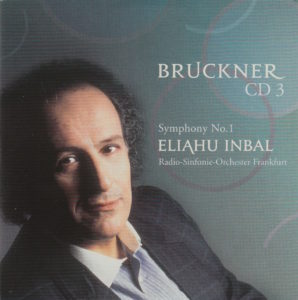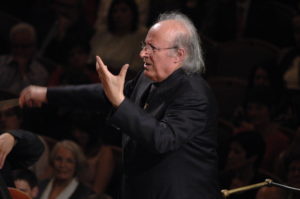 This morning, I am listening to Bruckner’s Symphony No. 1 in C Minor (WAB 101), nicknamed “The Saucy Maid,” interpreted by Israeli conductor Eliahu Inbal (1936-).
This morning, I am listening to Bruckner’s Symphony No. 1 in C Minor (WAB 101), nicknamed “The Saucy Maid,” interpreted by Israeli conductor Eliahu Inbal (1936-).
I had never heard of Maestro Inbal, which is a lot of fun for me because that means I get to research him.
His entry on Wikipedia tells me he,
…studied violin at the Israeli Academy of Music and took composition lessons with Paul Ben-Haim. Upon hearing him there, Leonard Bernstein endorsed a scholarship for Inbal to study conducting at the Conservatoire de Paris, and he also took courses with Sergiu Celibidache and Franco Ferrara in Hilversum, Netherlands. At Novara, he won first prize at the 1963 Guido Cantelli conducting competition.
Inbal has conducted a wide variety of works. He is best known for his interpretations of late-Romantic works, but is also noted as an opera conductor, and has given the premieres of a number of modern works.
Inbal’s orchestra is Radio-Sinfonie-Orchester Frankfurt, which Wikipedia tells me is,
…the radio orchestra of Hessischer Rundfunk, the public broadcasting network of the German state of Hesse. From 1929 to 1950 it was named Frankfurter Rundfunk-Symphonie-Orchester. From 1950 to 1971 the orchestra was named Sinfonie-Orchester des Hessischen Rundfunks, from then to 2005 Radio-Sinfonie-Orchester Frankfurt. For a long time the English translation Frankfurt Radio Symphony Orchestra was used for international tours, since 2015 the official international name is Frankfurt Radio Symphony.
The orchestra’s range of musical styles includes the classical-romantic repertoire, discoveries in experimental new music, concerts for children and young people and demanding programming concepts.
I’m going to refer to Radio-Sinfonie-Orchester Frankfurt by its new name – Frankfurt Radio Symphony – from now on, mmm kay?
Sharp minds among you may have noticed that my list of conductors looks like this:
Daniel Barenboim with the Berlinker Philarhmoniker
Daniel Barenboim with Staatskapelle Berlin
Sergiu Celibidache
Wilhelm Furtwangler
Eliahu Inbal
Marek Janowski
Otto Klemperer
Simone Young
So why am I listening to Eliahu Inbal instead of Sergiu Celibidache and Wilhelm Furtwangler, both of whom would follow Barenboim alphabetically?
Because the CD box sets by Celibidache and Furtwangler don’t include Bruckner’s Symphony No. 1. So I had to skip over them. The next name in line is Inbal.
Mystery solved.
Here are the objective stats about today’s performance:
 Bruckner’s Symphony No. 1 in C Minor (WAB 101), composed between 1865 and 1866
Bruckner’s Symphony No. 1 in C Minor (WAB 101), composed between 1865 and 1866
Eliahu Inbal conducts
Inbal used the “Linz version” according to the liner notes
Radio-Sinfonie-Orchester Frankfurt plays
The symphony clocks in at 48:17
This was recorded in Frankfurt, Germany, in 1987
Inbal was 51 when he conducted it
Bruckner was 42 when he finished composing it (the first time)
This recording was released on the Warner Classics & Jazz label/Teldec Classics label
Bruckner wrote his symphonies in four movements. The time breakdown of this one (Symphony No. 1 in C Minor), from this particular conductor (Inbal) and this particular orchestra (Frankfurt Radio Symphony) is as follows:
I. Allegro (C minor)……………………………………………………………………………………13:15
II. Adagio (A-flat major)………………………………………………………………………………………………………..12:29
II. Scherzo: Lebhaft (lively)—G minor – Trio: Langsam (slowly)—G major…………………………………………………………………………………………………………..8:22
IV. Finale: Bewegt und feurig (with motion and pep)—C minor…………………………………………………………………………………………………………14:10
Total running time: 48:17
For the Linz version, its entry on Wikipedia indicates,
1877/1884 version
Although often also called the Linzer Fassung (Linz version), this version was in fact made in Vienna. It is available in editions by Robert Haas (published 1935) and Leopold Nowak (published 1953). The vast majority of recordings, including the famous one featuring Eugen Jochum conducting the Dresden Staatskapelle, are of one of these two editions.
From what I can tell, there’s not really one version that is the “Linz version.” So I’m guessing the version used by Maestro Inbal was the 1877/1884 version, edited by either Leopold Nowak or Robert Haas.
Bruckner gave it the nickname “das kecke Beserl”, roughly translated as “saucy maid”.
Okay. Now, here are the subjective aspects:
My Rating:
Recording quality: 4
Overall musicianship: 4
CD liner notes: 3 (very thin booklet, sparse essay about Bruckner translated into English, German, and French; no information at all about Eliahu Inbal)
How does this make me feel: 4
 The photo of Maestro Inbal on the cover of this CD box set appears to have been taken 20-30 years ago. He is much older these days (who isn’t?), with wispy gray-white hair.
The photo of Maestro Inbal on the cover of this CD box set appears to have been taken 20-30 years ago. He is much older these days (who isn’t?), with wispy gray-white hair.
See?
Not that it matters to me.
I noticed it when I conducted (no pun intended) research on him and discovered he no longer looks that way.
Back to the music.
This is an interesting performance. It is lush, weighty, often somber, occasionally joyous, and – if I had to assign a mood to it – reverent to the point of ponderous at times. Especially the Adagio.
All bets are off when it comes to the Scherzo, though. That’s as raucous and brash as it’s supposed to be. Still one of my favorite movements in all Brucknerdom.
The Finale gets a bit brassy at times. But it’s stirring. And utterly captivating.
This is a very sold, grand, exciting performance.
Highly recommended.
